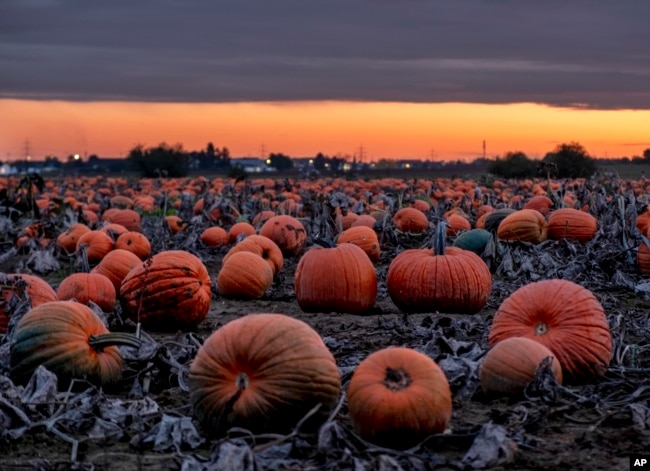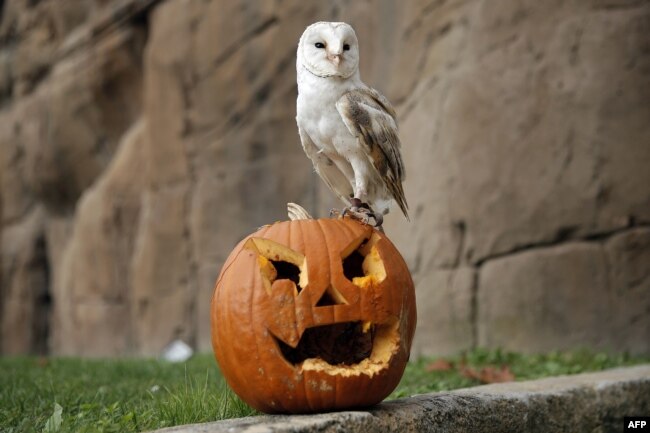ハロウィン せめて知ろうよ仮装の前に!!
アメリカ、ドイツ、オランダに住んでいたころを思い出します。子どもたちが仮装して「トリック・オア・トリート!」と言いながら近所の家々を回ってきて、こっちはたくさんのお菓子を用意して(結構大変)あげるのがお決まり。カボチャをくり抜いたジャック・オ・ランタンやおばけ、クモの巣など、ハロウィンならではのシンボルを家の周りに飾り付けてました。
「仮装を楽しむ日」として日本で定着した感があるハロウィンですが、それだけでいいのでしょうか!?
ハロウィーン、クリスマス、バレンタイン、復活祭。
なんでも商業化してしまう日本人。
なんでも楽しむだけのイベントにしちゃう日本人。
そもそもハロウィンって???
その起源は???
なんでジャック???
なんで怖い仮装するの???
せめて、知りましょう!!!
今年も、もうすぐ10月31日がやってきます。
ただ楽しむだけのイベントにしますか?
さあ、今日の Words and Their Stories from VOA Learning English!!
Here we go!!
ジャック・ランタン :なぜ'ジャック'と名付けられているの?
Jack-o'-Lantern: Why Is It Named 'Jack'?
Oct.25.2020
ハロウィンの最も有名なしるしの一つは、ジャック・オー・ランタンです。10月31日、ハロウィーンの夜に無数のアメリカの家の前の階段でジャック-オー-ランタンを見つけることができます。
休日のためにカボチャを飾ることは、特に子供たちにとって、多くの楽しみがあります。多くの人は、店から、または農場からの本物のカボチャ畑からカボチャを購入します。
ジャック・オー・ランタンを作るには、時間と少なくとも良い、鋭いナイフが必要です。ですから、両方をたくさん持っていることを確認してください。これが、子供たちが年上の誰かと一緒にこの活動をする理由です。
まず、かぼちゃの茎、または上部を切り落とします。でも、それを捨ててはいけませんよ。後でジャック・オー・ランタンを完成させるために必要になります。さて、カボチャの中に手を伸ばして、中のものをすべて取り除きます。そして、そう-- ぬるぬるした感じ。
次に、かぼちゃの皮、または皮の上に顔か何かの絵を作ります。その後、慎重にアートワークの線に沿って切ってください。
最後に、カットしたデザインを点灯するために内部にキャンドルや他のいくつかの照明を入れます。はい! かぼちゃがジャック・オー・ランタンに変身しました。
さて、いくつかの疑問があるかもしれません。例えば、なぜジャック・オー・ランタンという言葉は男性の名前-- “Jack?”
メリアムウェブスターのオンライン辞書に説明があります。それによると、17世紀イギリスの人々がこの用語を使い始めたそうです、”ランタンを持った男” や夜警を意味していました。
当時イギリスに住んでいた人々は知らない男のことを "ジャック "と呼んでいたと言われています。そのため、提灯を持っている見知らぬ男を、”ランタンを持った男”や "ランタンのジャック"と呼ばれることもあったそうです。
次の疑問はこれかもしれません: でも、これがハロウィンと何の関係があるの?
メリアムウェブスターとブリタニカ百科事典 の両方によると、この用語 "jack-o'-lantern "は、ケチなジャックという名前の男についてのとても古いアイルランドの物語に由来しているとあります。
この話によると、彼はお金を得るために悪魔を騙しました。ジャックが死んだとき、神は彼を天国に行かせることを拒否しました。悪魔は、まだ騙されたことに怒っていましたが、ジャックが地獄に行くことも許しませんでした。
ですから、ジャックの罰は永遠に地上をさまようことになりました。彼の魂は動けなくなったのです。そして、地球に閉じ込められたおおくの魂のように、彼はおそらく人間を怖がらせようとすることに時間の大半を費やしました。少なくとも、私は 追い詰められた魂はそうするだろうと想像しています。
自分自身を守り ジャックの放浪する魂を 追い払うために、 アイルランドの人々は カブに怖い顔を彫っていました 当時、カブは一般的な根菜類だったのではないかと私は思っています。
アイルランドの家族がアメリカに移住したとき、彼らはこの伝統を持ってきました。これらの移民は、新しい家ではカブよりも一般的だったカボチャからジャック・オー・ランタンを彫り始めました。
ハロウィーンは、古代からのケルト人のお祝いに基づいています。夏の終わりを告げます。この時期には、その年に亡くなった人の魂が家を訪れるために戻ってくると信じられていました。
ブリタニカ百科事典 は、8世紀ローマ・カトリック教会が宗教的な日である All Saints’ Day万聖節 を11月1日に移したと説明しています。これにより、All Hallows' Eveオールハロウズイヴ、ハロウィーンは10月31日になりました。
そのような死者の魂から身を隠すためにコスチュームを着て、ジャック・オー・ランタンを彫るなど、古いケルト人のお祝いからの伝統が残っています。
今日では、ハロウィンを祝う人々は両方を行い続けています。
::::::::::::::::::::::::
古代ケルト人たちが収穫を祝い「先祖の霊を迎える日」だった。つまりは「西洋のお盆」といったところで、なんだか親近感が湧いてきますね。
Jack-o'-Lantern: Why Is It Named 'Jack'?
 FILE - Pumpkin Jack O' Lanterns sit on the grounds of the historic Van Cortlandt Manor House and Museum during the "Great Jack O' Lantern Blaze" in Croton-on Hudson, New York, Oct. 27, 2015. (REUTERS/Mike Segar)
FILE - Pumpkin Jack O' Lanterns sit on the grounds of the historic Van Cortlandt Manor House and Museum during the "Great Jack O' Lantern Blaze" in Croton-on Hudson, New York, Oct. 27, 2015. (REUTERS/Mike Segar)
One of the most well-known signs of Halloween is the jack-o’-lantern. You can find jack-o'-lanterns on the front steps of countless American homes on October 31, Halloween night.
Decorating a pumpkin for the holiday can be a lot of fun, especially for children. Many people buy a pumpkin from a store or from a real pumpkin patch on a farm.
Making a jack-o'-lantern takes time and at least one good, sharp knife. So, make sure you have plenty of both. This is why children do this activity with someone older.
First, cut off the stem, or top of the pumpkin. But don’t throw it out. You will need it later to finish the jack-o'-lantern. Now, reach your hands inside the pumpkin and remove everything inside. And yes -- it will feel slimy.
Next, make a picture of a face or something else on the skin, or rind, of the pumpkin. Then, carefully cut along the lines of your artwork.
Finally, put a candle or some other lighting inside to light up the design you have cut. And there! You have turned a pumpkin into a jack-o'-lantern.
Now, you might have a few questions. For example, why does the term jack-o’-lantern have a man’s name -- “Jack?”
Merriam-Webster’s online dictionary gives one explanation. It says people in England began using the term in the 17th-century. It meant “a man with a lantern” or a night watchman.
At that time, people living in England reportedly called a man they did not know “Jack.” So, an unknown man carrying a lantern was sometimes called "Jack with the lantern" or "Jack of the lantern."
Your next question might be: But what does this have to do with Halloween?
Merriam-Webster and Encyclopedia Britannica both say the term “jack-o'-lantern” comes from a very old Irish story about a man named Stingy Jack.
As the story goes, he tricked the Devil to get money. When Jack died, God refused to let him go to heaven. And the Devil, still angry about being tricked, did not allow Jack to go to hell either.
So, Jack’s punishment was to wander the earth forever. His soul was stuck. And like most spirits trapped on Earth, he probably spent most of his time trying to frighten humans. At least, that’s what I imagine trapped souls would do.
To protect themselves and frighten away Jack’s wandering soul, people in Ireland would carve scary faces on turnips. I suspect that turnips were a common root vegetable at the time.
When Irish families moved to the United States, they brought this tradition with them. These immigrants began carving jack-o'-lanterns from pumpkins, which were more common than turnips in their new home.
Halloween is based on the Celtic celebration from ancient times. It marked the end of summer. It was believed that during this time of the year, the souls of those who had died that year would return to visit their homes.
Encyclopedia Britannica goes on to explain that in the 8th century, the Roman Catholic Church moved All Saints’ Day, a religious day, to November 1. This meant that All Hallows’ Eve, or Halloween, fell on October 31.
Traditions from the old Celtic celebration remained, such as wearing costumes to hide yourself from the souls of the dead and carving jack-o’-lanterns.
Today, people who celebrate Halloween continue to do both!
________________________________________________________________
Words in This Story
lantern – n. a usually portable lamp with a protective covering
decorate – v. to make (something) more attractive usually by putting something on it
pumpkin patch – n. a small piece or area of land where this usually large round orange fruit of a vine related to the squash and cucumber that is used for food or decoration grows : a patch is often different from what is around it
candle – n. wax that has been formed into a stick or another shape and has a string in the middle that can be burned
slimy – adj. having a wet, slippery feel or look
heaven – n. the place where God lives and where good people go after they die according to some religions
hell – n. the place where the devil lives and where evil people go after they die according to some religions
wander – v. to move about without a fixed course, aim, or goal
carve – v. to cut (something, such as a pattern or design) into a surface
costume – n. the clothes that are worn by someone (such as an actor) who is trying to look like a different person or thing


